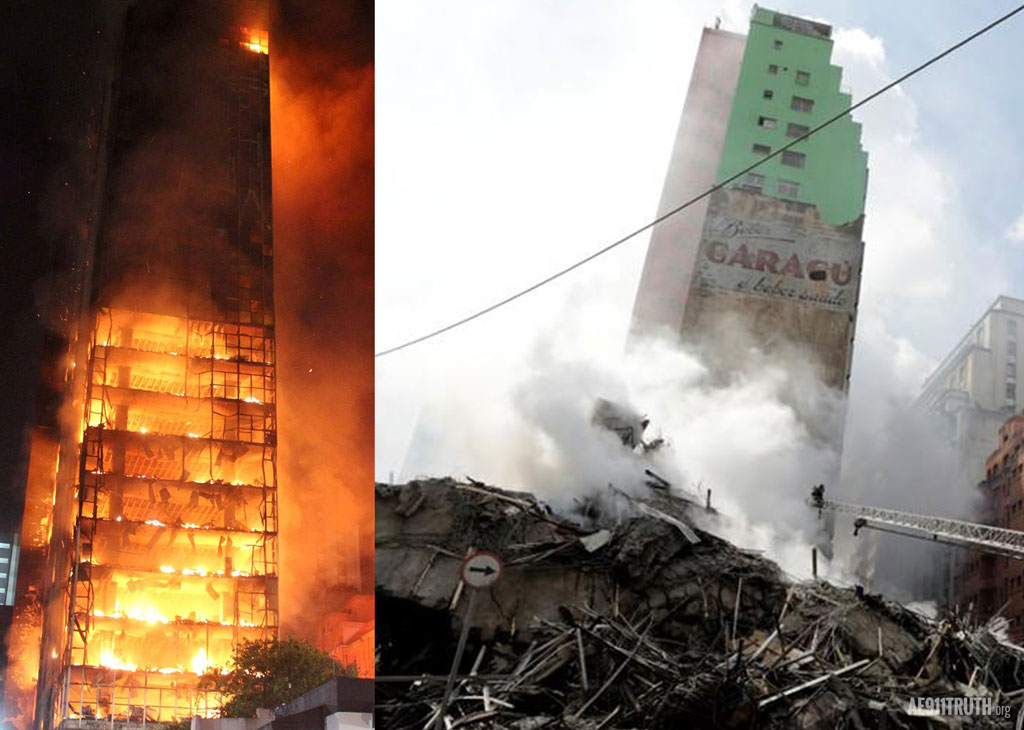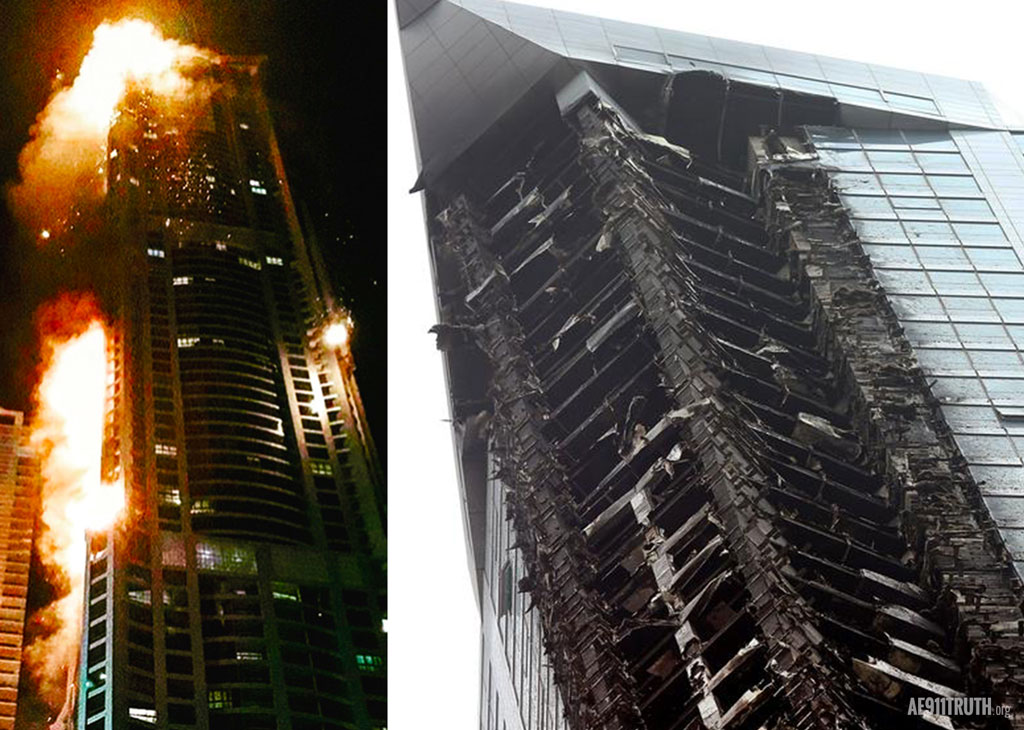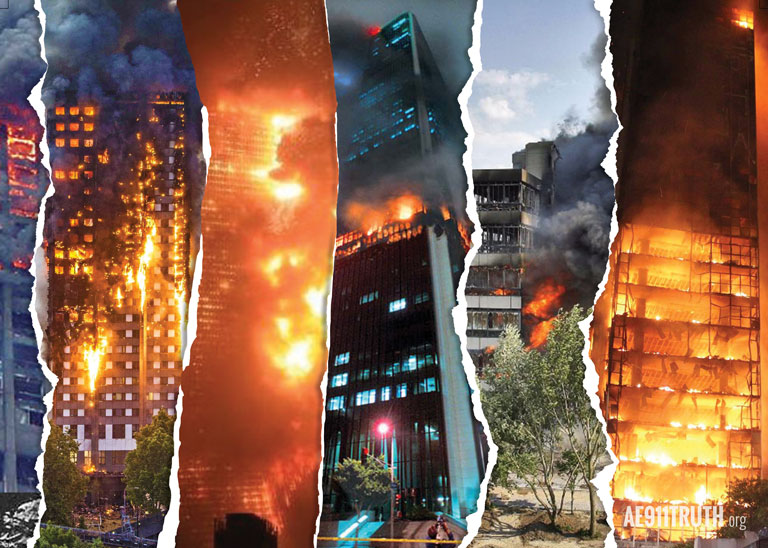
10 Mar 2020 – This article is a record of major high-rise fires around the world over the past 50 years. As the record shows, neither before nor since 9/11 has a steel-frame, fire-protected high-rise experienced a total collapse due to fire — much less a collapse exhibiting all the features of controlled demolition, as was observed in the destruction of the three World Trade Center skyscrapers on September 11, 2001.
Given that fires have scarcely caused even partial collapses in steel-frame, fire-protected high-rises, and given the rapid, symmetrical, total destruction of the three World Trade Center skyscrapers in one day, it is inexcusable that federal investigators did not make controlled demolition their primary hypothesis early on in the investigation.
This record of major high-rise fires will be updated when future fires occur, and it is not necessarily comprehensive. If you are aware of a major high-rise fire that is not included, please contact us.
Table of Contents:
I. Major High-Rise Fires Resulting in No Collapse
II. Major High-Rise Fires Resulting in Partial Collapse
III. Major High-Rise Fires Followed by Total Collapse
Major High-Rise Fires Resulting in No Collapse
Steel-frame High-rises with Fire Protection
World Trade Center Building 1 in lower Manhattan (1975)
World Trade Center Building 1, otherwise known as the North Tower, was a 110-story steel-frame, fire-protected skyscraper. Its 11th floor suffered a fire from an unknown cause on February 13, 1975. The fire started shortly before midnight in a furnished office on Floor 11 and spread through some 65% of the floor (the core plus half of the office area). By the time firefighters arrived, flames were also spreading vertically via telephone cable openings in the floor slabs, causing subsidiary fires from the 9th floor to the 19th. The fire lasted more than three hours and did an estimated $2 million worth of damage. Cleaning and service personnel were evacuated without any fatalities. However, of the 150 firefighters at the scene, 28 sustained injuries from the intense heat and smoke. According to Captain Harold Kull of Engine Co. 6, “It was like fighting a blow torch. Flames could be seen pouring out of 11th floor windows on the east side of the building.” WTC 1’s undamaged structural steel trusses did not need to be replaced. (Source)
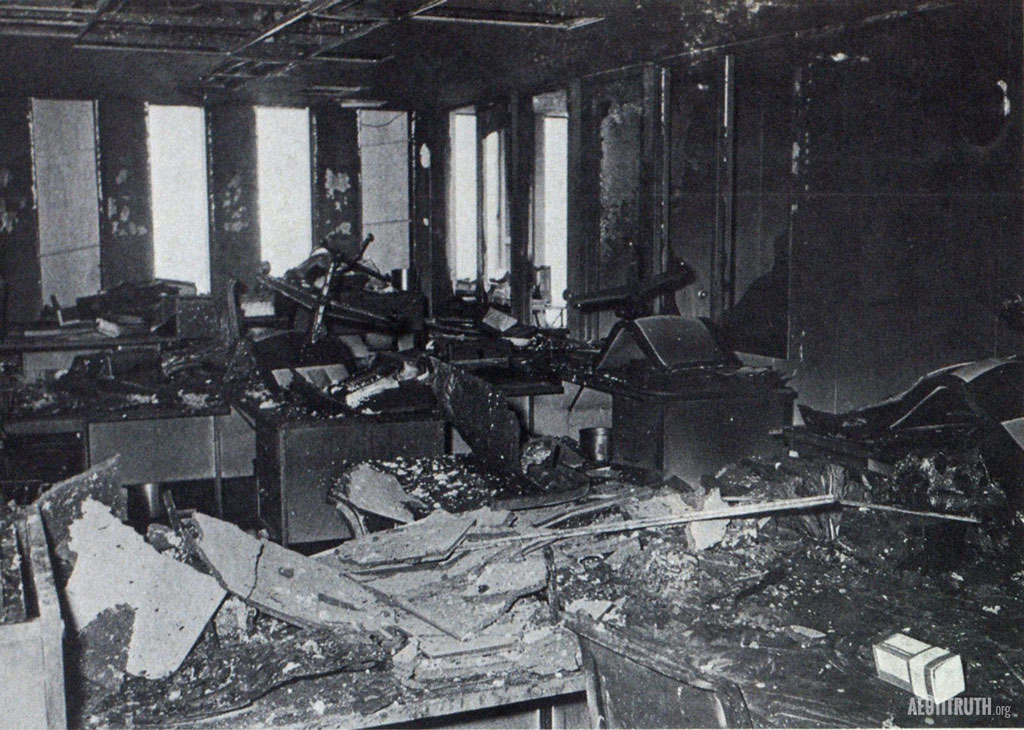
First Interstate Bank in Los Angeles, California (1988)
The First Interstate Bank is a 62-story steel-frame skyscraper that suffered the worst high-rise fire in the city’s history. From late one spring night through early morning the next day, 64 fire companies battled the blaze, which lasted for 3½ hours and caused an estimated $200 million of property damage. Of that fire, the U.S. Fire Administration wrote: “In spite of the total burnout of four and a half floors, there was no damage to the main structural members and only minor damage to one secondary beam and a small number of floor pans.” (Source 1 page 11, Source 2)
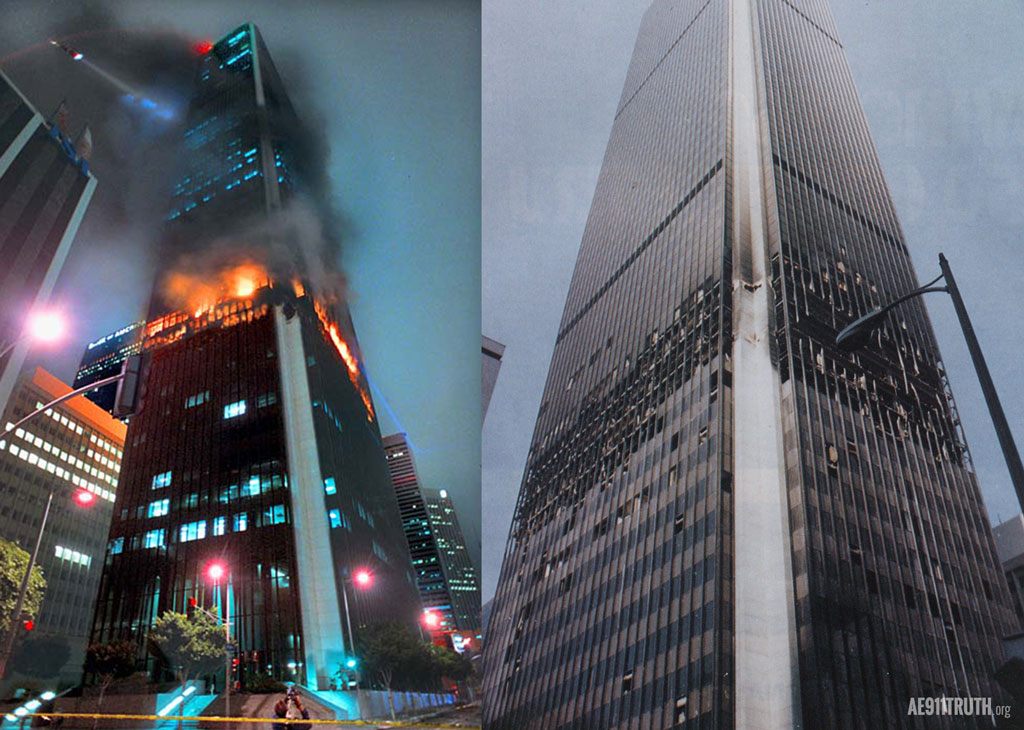
One Meridian Plaza in Philadelphia, Pennsylvania (1991)
One Meridian Plaza is a 38-floor steel-frame skyscraper. It suffered a severe fire that started on the 22nd floor and raged for 18 hours, gutting eight floors, causing an estimated $100 million in direct property loss, and killing three firefighters. Despite the severity and duration of the fire, as evidenced by the damage the building sustained, no part of the building collapsed. Fire and safety officials said later that it was in no danger of collapsing. (Source 1, Source 2)
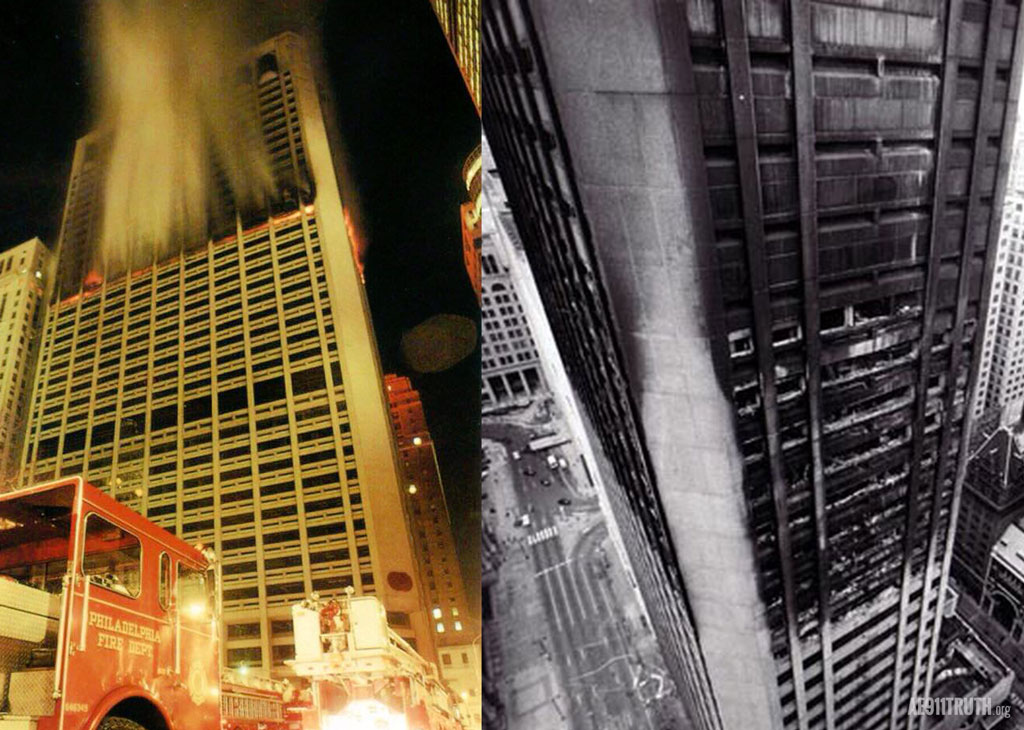
Mercantile Credit Insurance Building in Basingstoke, UK (1991)
The Mercantile Credit Insurance Building is a 12-story high-rise that has a fire-resistive steel frame with composite floor beams. Despite having no sprinklers, the building survived a four-hour fire that completely burned out three floors. No structural repair was required on the protected steel. (Source 1, Source 2)
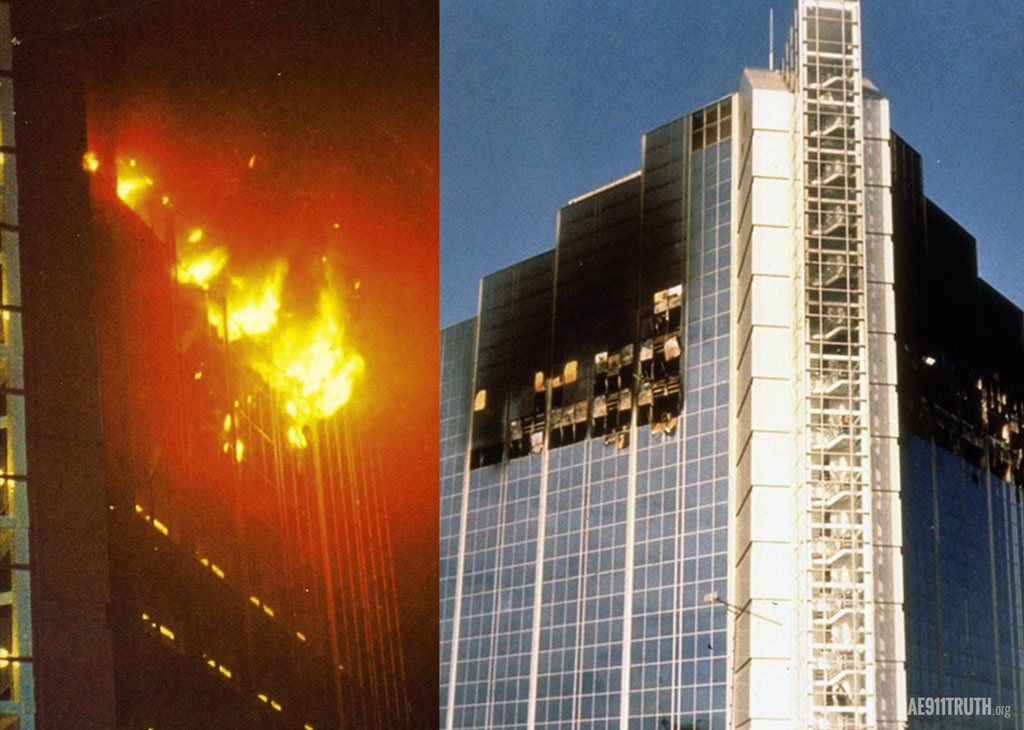
Deutsche Bank Building in lower Manhattan (2007)
The Deutsche Bank Building was a steel-frame skyscraper adjacent to the World Trade Center. It had been called Bankers Trust Plaza before Deutsche Bank acquired Bankers Trust in 1998. In 2007 the then-abandoned office building, originally 40 stories, was being abated and dismantled, floor by floor, six years after it had incurred massive damage from debris hurled into it by WTC 2’s explosion on September 11, 2001 (see below). By 2007, the structure had been reduced to 26 stories. A mid-afternoon seven-alarm fire, inadvertently started by workers who had been smoking, broke out on the 17th floor. The fire, which burned for seven hours, heavily damaged five floors above and five floors below its point of origin. Two firefighters died of smoke inhalation. The structure did not collapse. (Source 1, Source 2, Source 3)
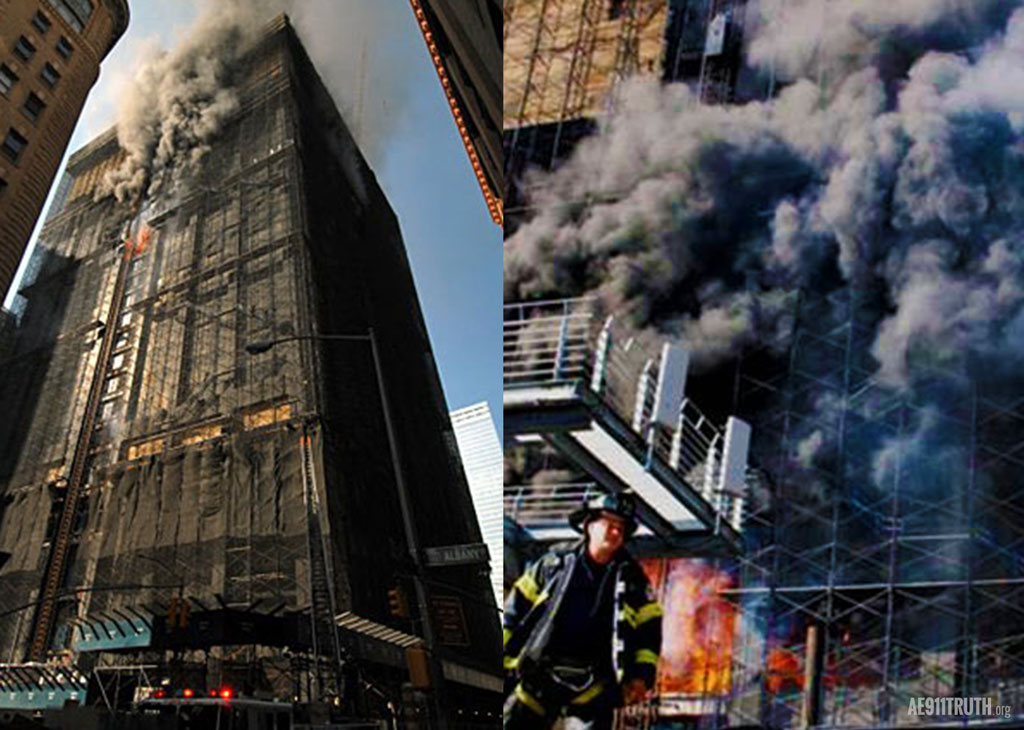
Mandarin Oriental Hotel/Beijing Television Cultural Center in Beijing, China (2009)
The Mandarin Oriental Hotel was a not-yet-completed 44-story, 522-foot steel-frame skyscraper that was engulfed in flames for more than five hours on February 9, 2009. The cause of the fire was said to be an unauthorized fireworks display during the Lunar New Year celebration. One firefighter died fighting the blaze. The Mandarin Oriental Hotel’s architect, Rem Koolhaus, said that the skyscraper, built with 140,000 tons of steel, incurred no structural damage and did not collapse. Nonetheless, it was later rebuilt. (Source 1, Source 2, Source 3)
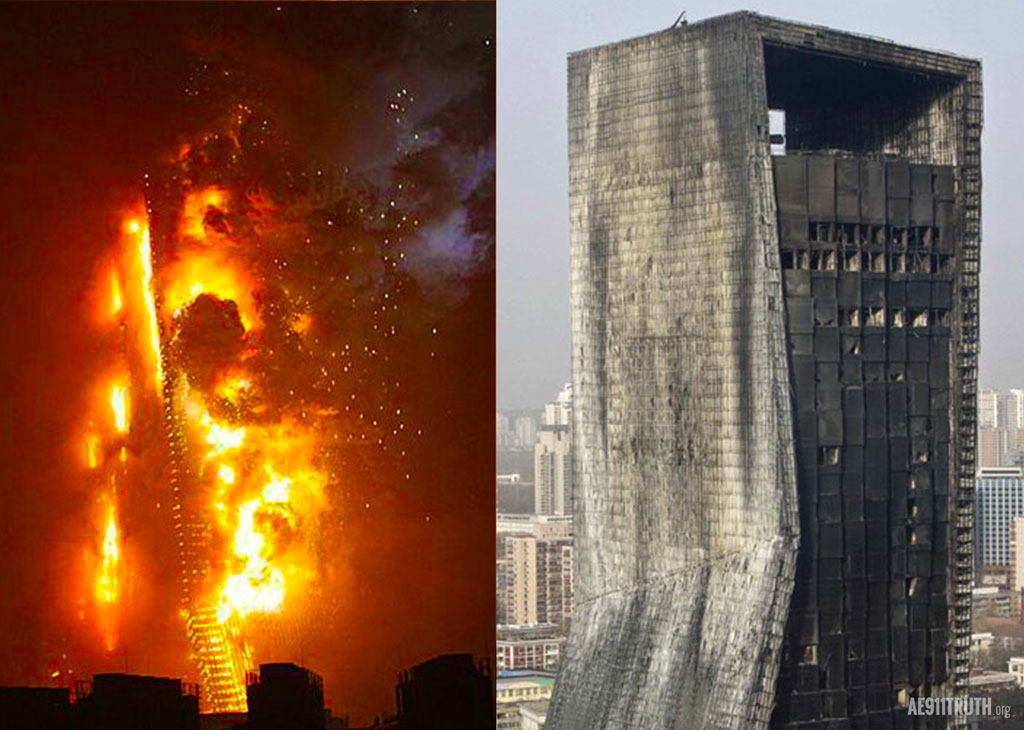
A Shanghai, China, steel-frame high-rise apartment building (2010)
A Shanghai steel-frame high-rise apartment building was undergoing renovation broke out in a fire that burned throughout all 28 stories. Started by sparks that ignited scaffolding being welded by unlicensed workers, the fire burned for several hours and required more than 80 fire engines to contain it. It killed at least 58 people and injured more than 70 others. Firefighters on the ground were unable to hose water on the top of the 279-foot building. The structure did not collapse. (Source 1, Source 2)
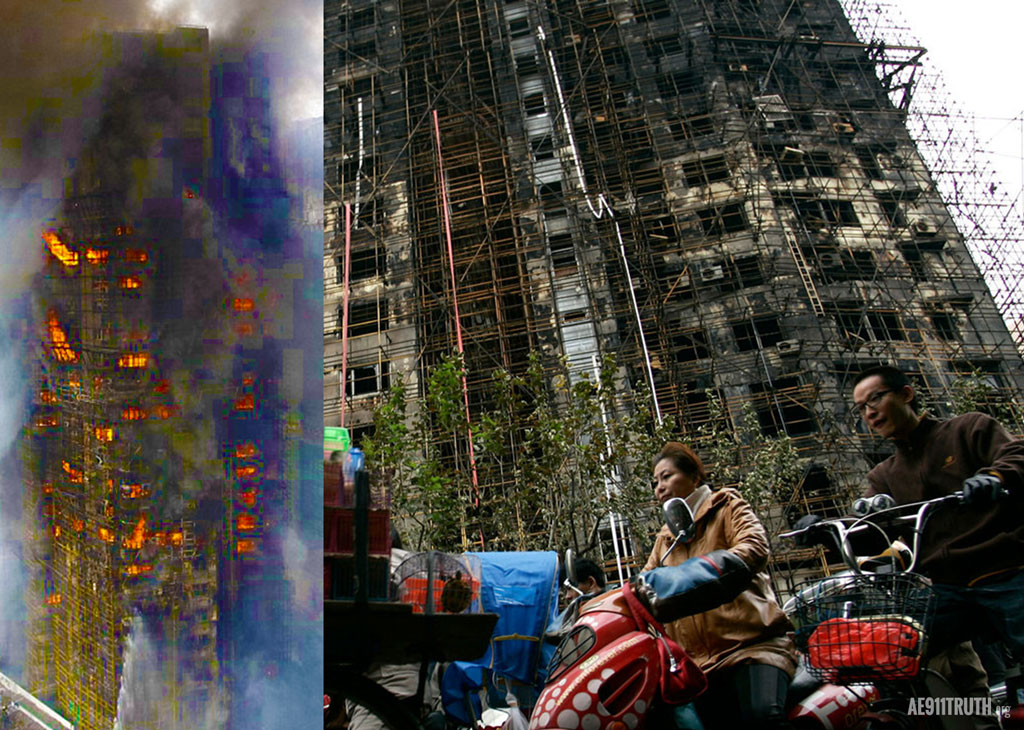
Other Types of Construction and Fireproofing
Andraus Building, São Paulo, Brazil (1972)
The Andraus Building is a 31-story office building with reinforced concrete framing. The extremely hot fire that broke out caused severe spalling of large portions of the exterior concrete walls, joists, and columns, exposing the reinforcing steel. Nevertheless, the building did not collapse. It was subsequently repaired and returned to service. (Source)
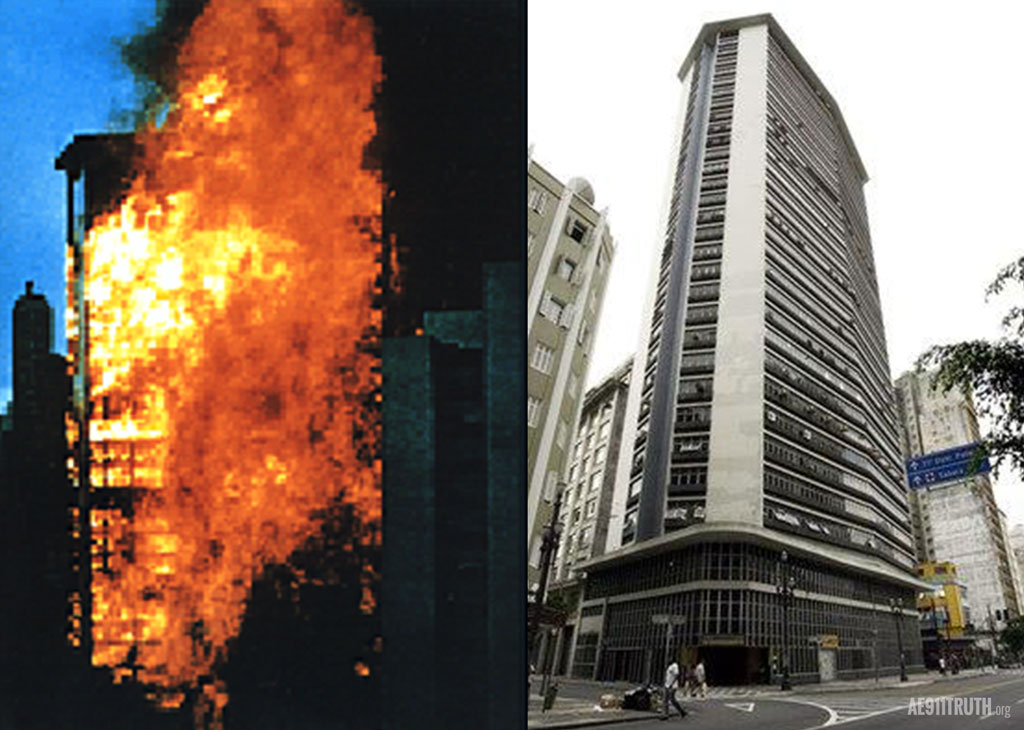
Joelma Building (Crefisul Bank), São Paulo, Brazil (1974)
The Joelma Building is a 25-story office building made with reinforced concrete framing. Like the Andraus building (above), it suffered from severe spalling that exposed the steel reinforcing, but there was no collapse. Like the Andraus, it reopened after repairs. (Source)
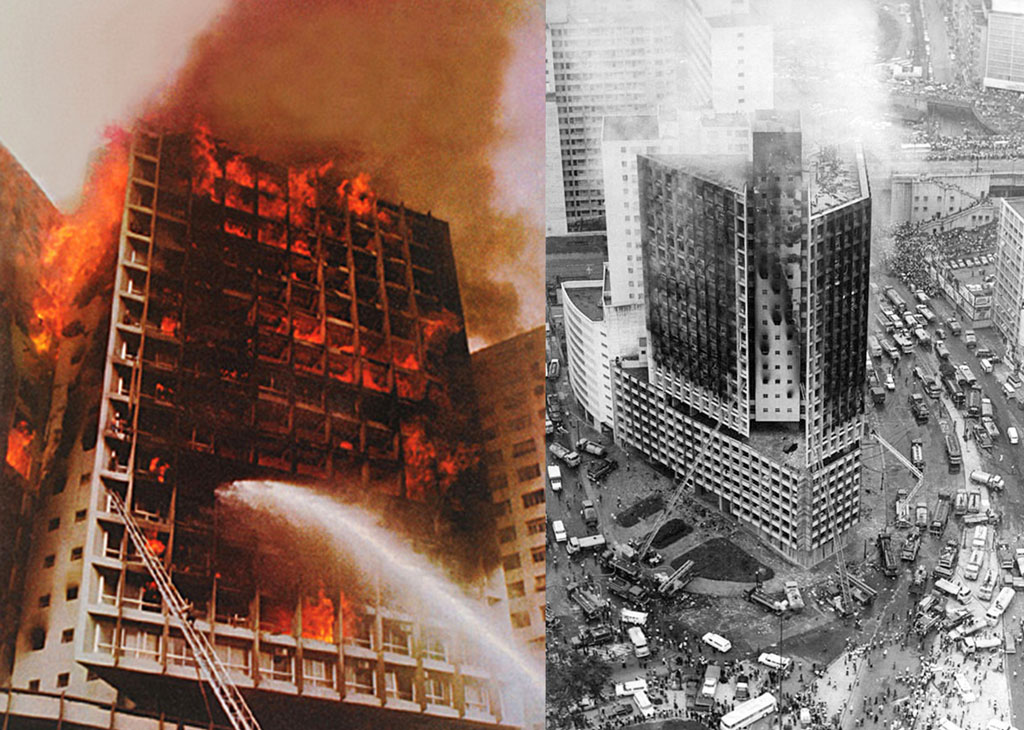
MGM Grand Hotel, Las Vegas, Nevada (1980)
The MGM Grand Hotel is a 26-story hotel and casino. It is a mixture of reinforced concrete and steel framing. The building had a partial sprinkler system, but the casino and the deli, where the fire began, had no sprinklers. Once the deli was fully involved, the fire spread to the casino, where it raged out of control. The Las Vegas Fire Department was able to confine the blaze to the casino level. Although it burned for about six hours and caused great loss of life, the fire did not result in the building’s collapse. (Source 1, Source 2)
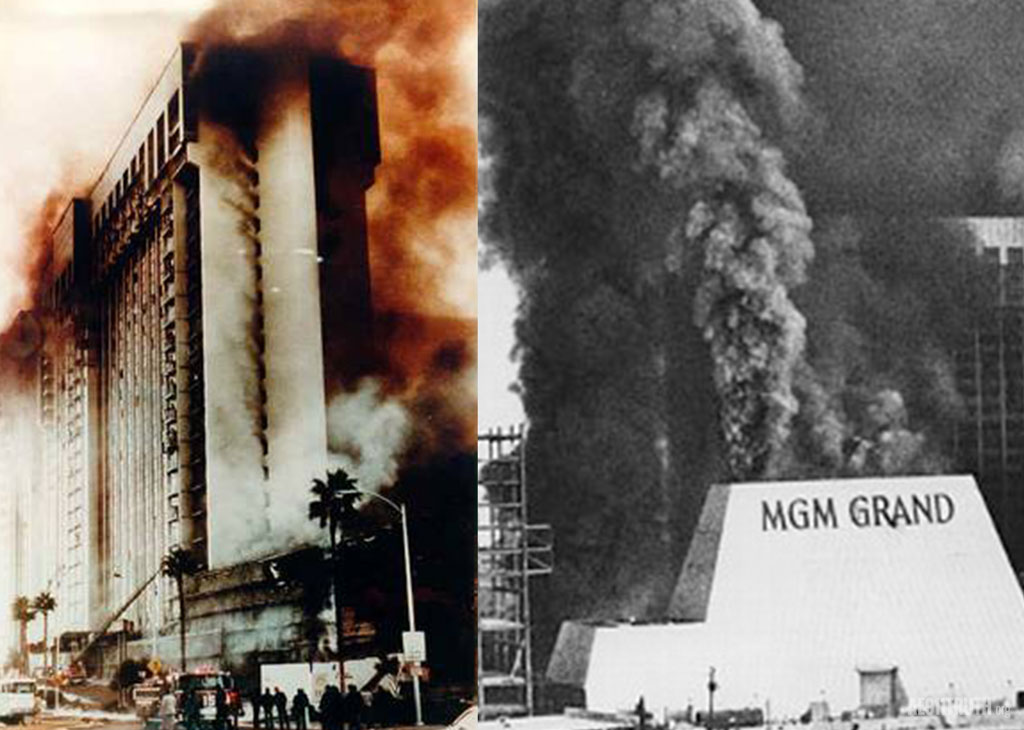
The Dubai Tamweel in Dubai, UAE (2012)
The Dubai Tamweel is a 34-story residential tower made of reinforced concrete. The structure was partially gutted by fire after a blaze started at 1:30 AM. Although it was engulfed in flames and declared “uninhabitable,” the structure did not collapse. Following comprehensive rehabilitation, the tower was restored. (Source 1, Source 2, Source 3)
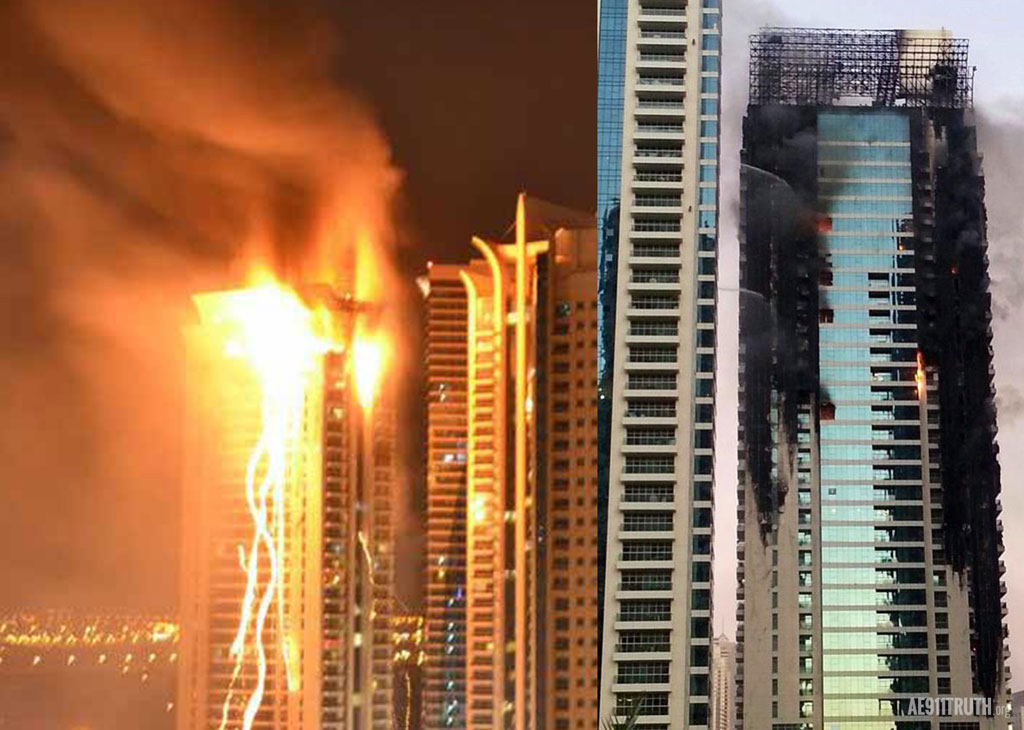
Grosney Tower in Chechnya, Russia (2013)
The Grosney Tower experienced a fire that destroyed the plastic trimming on the exterior but left the building’s interior untouched. There was no collapse. (Source)

The Marina Torch in Dubai, UAE (2015)
The Marina Torch is, at 1,105 feet, one of the world’s tallest residential towers. It is made of reinforced concrete. The upper portion of its 79 stories was gutted by an inferno in the early morning hours. The flames, which started from an unknown cause, swept across the tower’s façade, affecting 20 stories. Shattered glass and debris from the exterior of the building fell in fireballs to the ground. Firefighters battled the blaze for more than two hours. The structure did not collapse. (Source 1, Source 2)
“Address Building” in downtown Dubai, UAE (2015)
The “Address Building” is a 63-story five-star hotel and apartment complex in central downtown Dubai. It is made of reinforced concrete. As the city was preparing for New Year’s Eve celebrations on the last day of the year, the building became engulfed in flames. The fire started on the 20th floor and quickly spread to the exterior, which one eyewitness said went up “like paper.” According to one newspaper, internal fire extinguishing systems appeared to have worked, giving everyone inside the hotel time to get out alive. The Address has nearly 200 hotel rooms and more than 600 apartments. A total of 16 people were injured and one was killed. The structure did not collapse. (Source 1, Source 2)
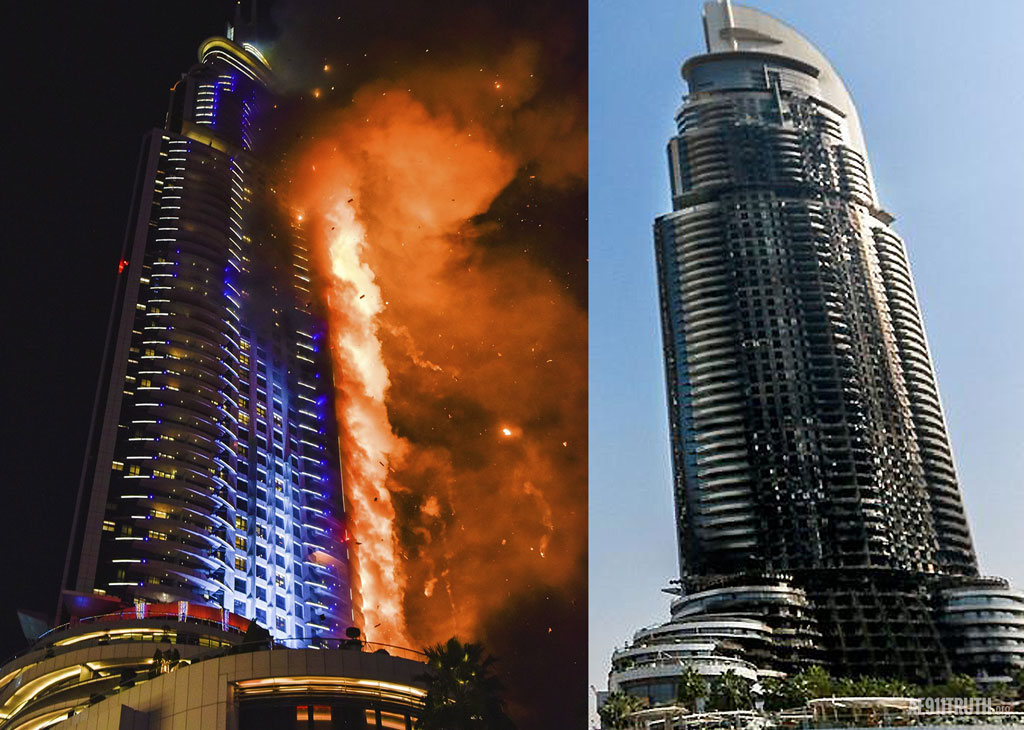
Grenfell Tower in West London, U.K. (2017)
Grenfell Tower is a reinforced-concrete structure built in 1974 and containing 120 residential flats (some in low-rise buildings and others in a 24-story tower), was significantly refurbished in 2016. Exterior insulation was added. The new cladding not only contained flammable materials (polyethylene insulation covered by thin aluminum sheets that buckle in high temperatures and expose the internal material to flames) but it was installed onto the existing incombustible reinforced-concrete structure. In June 2017, a fire broke out on the 4th floor of the 24-story block of flats. It burned for 60 hours and caused 72 deaths. More than 70 other residents were injured and another 223 escaped. Though Grenfell Tower did not collapse, residents of surrounding buildings were evacuated as a precaution; later the building was determined to be structurally sound. Demolition of Grenfell Tower is expected by 2022. (Source 1, Source 2, Source 3)
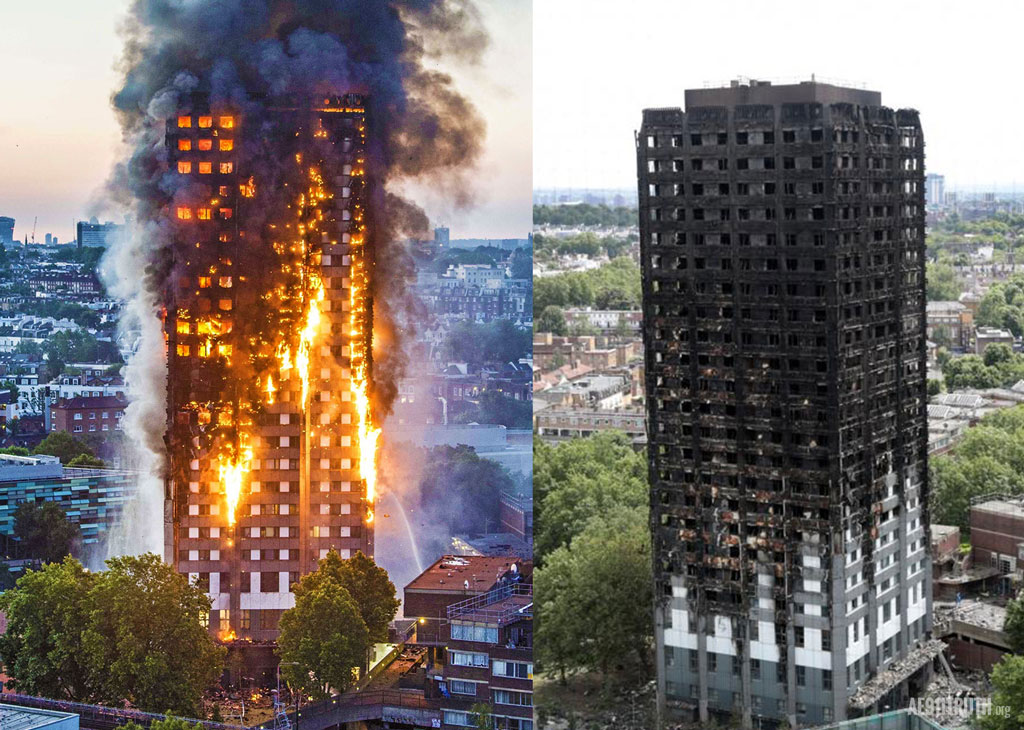
Warsaw Hub in Warsaw, Poland (2019)
The Warsaw Hub is a 31-story reinforced concrete building that was under construction when its upper floors caught fire. It was previously known as Sienna Towers. Although the area around the Warsaw Hub was closed to the public as a safety precaution, the fire brigade said the fire did not damage the structural integrity of the building, which was in no danger of collapse. (Source 1, Source 2, Source 3)
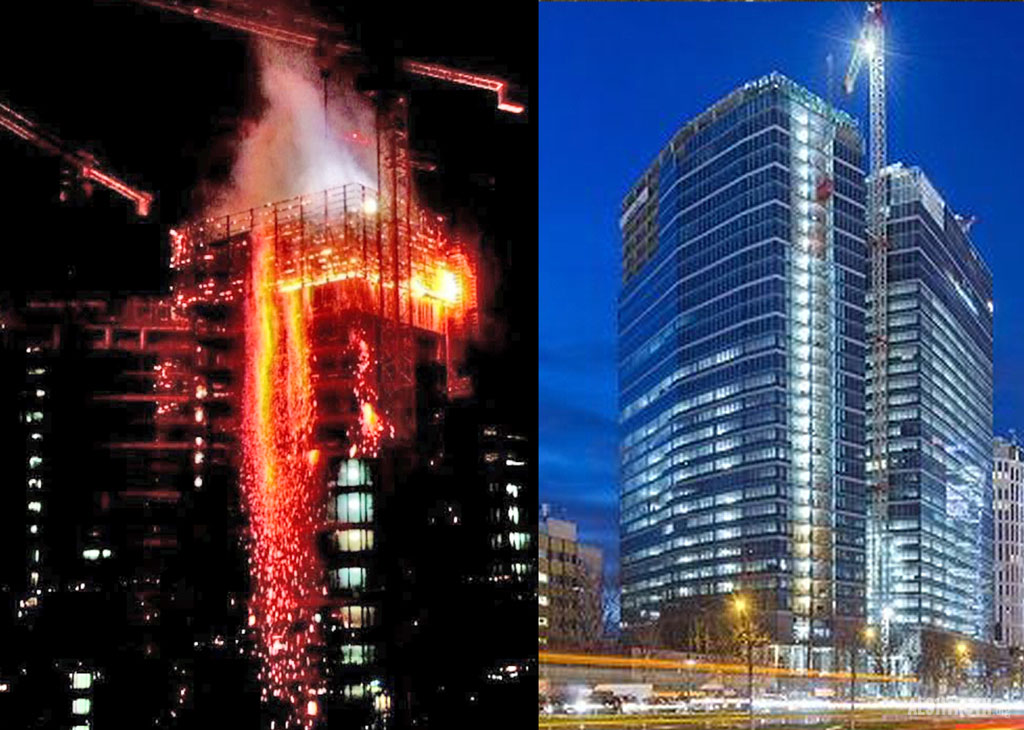
Major High-Rise Fires Resulting in Partial Collapse
Steel-frame High-rises with Fire Protection
Alexis Nihon Plaza in Montreal, Canada (1986)
The Alexis Nihon Plaza is a 15-story steel-frame office building. It was built atop a five-story concrete mall and parking garage. The beams and floors had a three-hour fire rating, while the columns had a two-and-a-half-hour rating. All building elements were insulated with spray-applied mineral fiber fireproofing. There was no automatic sprinkler system installed in the building. Approximately five hours after the fire started, a section of the 11th floor collapsed onto the 10th floor. The steel structure did not collapse. (Source)
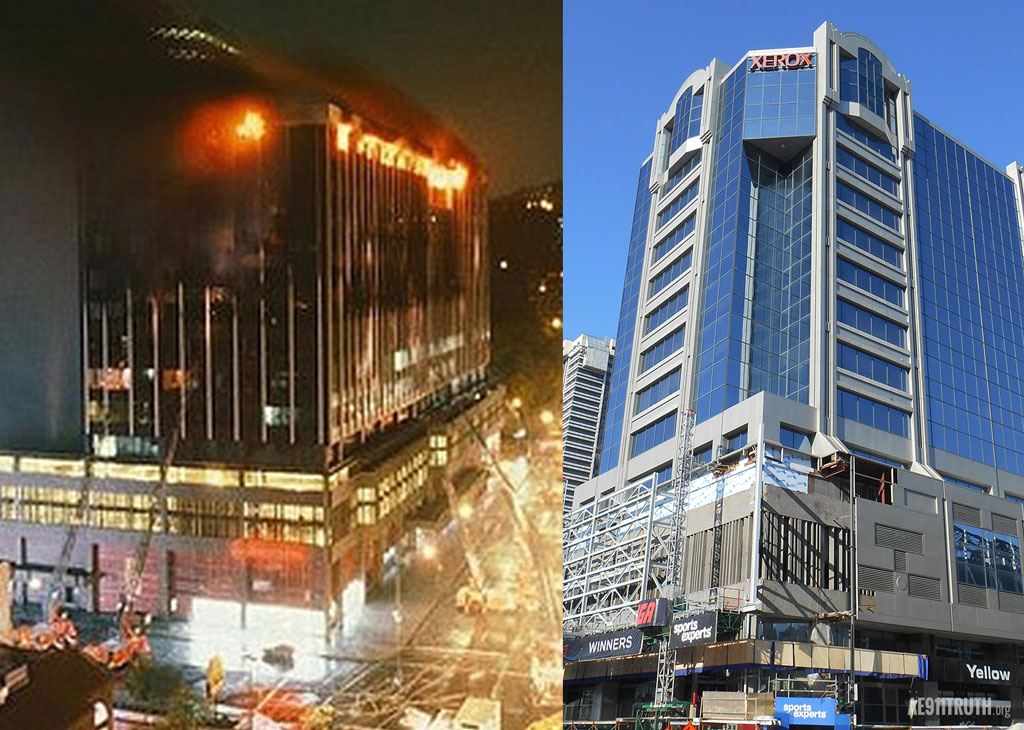
World Trade Center 5 in lower Manhattan (2001)
World Trade Center 5 is a nine-story steel-frame building that was engulfed in fires on September 11, 2001, after sustaining heavy damage from falling debris. The fires were much more severe and widespread than those in the 47-story World Trade Center 7. Though there were some partial interior collapses in WTC 5, the overall structure remained standing. (Source)
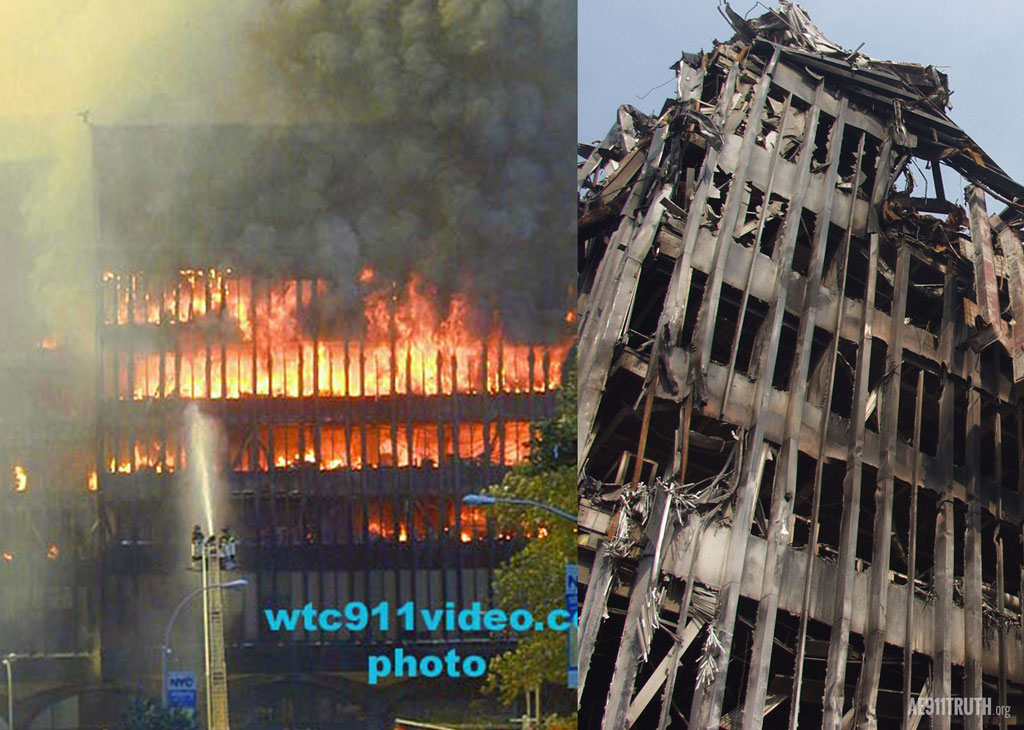
Other Types of Construction and Fireproofing
1 New York Plaza in New York City (1970)
1 New York Plaza is a 50-story skyscraper that has a reinforced concrete core with an outer structural steel frame and a composite floor system. It suffered a severe fire and explosion. The fire started around 6:00 PM on the 33rd and 34th floors and burned for more than six hours. The fire caused shear connections to fail and beams to drop onto girder flanges, resulting in only a partial collapse of the 34th floor. The structure remained standing. (Source 1, Source 2, Source 3)
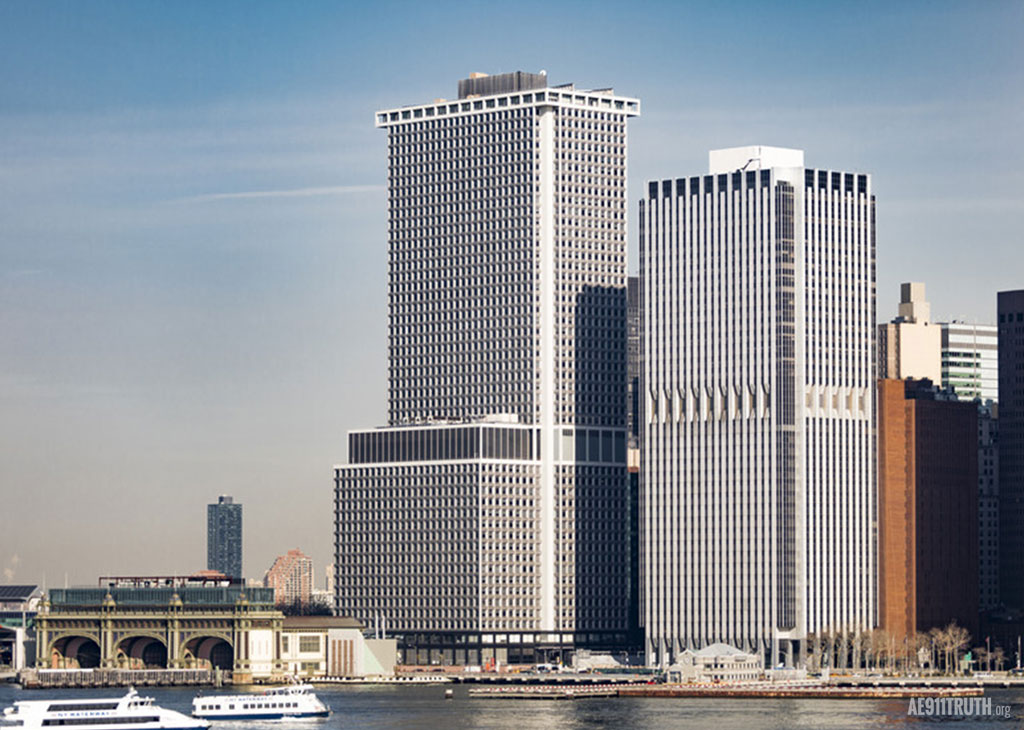
Katrantzos Sport Department Store in Athens, Greece (1980)
Katrantzos Sport Department Store was an eight-story reinforced concrete building. Its fire started at the 7th floor and rapidly spread throughout the building due to lack of both vertical and horizontal compartmentalization and the absence of an automatic sprinkler system. Collected evidence indicated that fire temperatures reached 1,000ºC over the two-to-three-hour fire’s duration. The store suffered partial collapses of two floors (the 5th and 8th). (Source 1, Source 2)
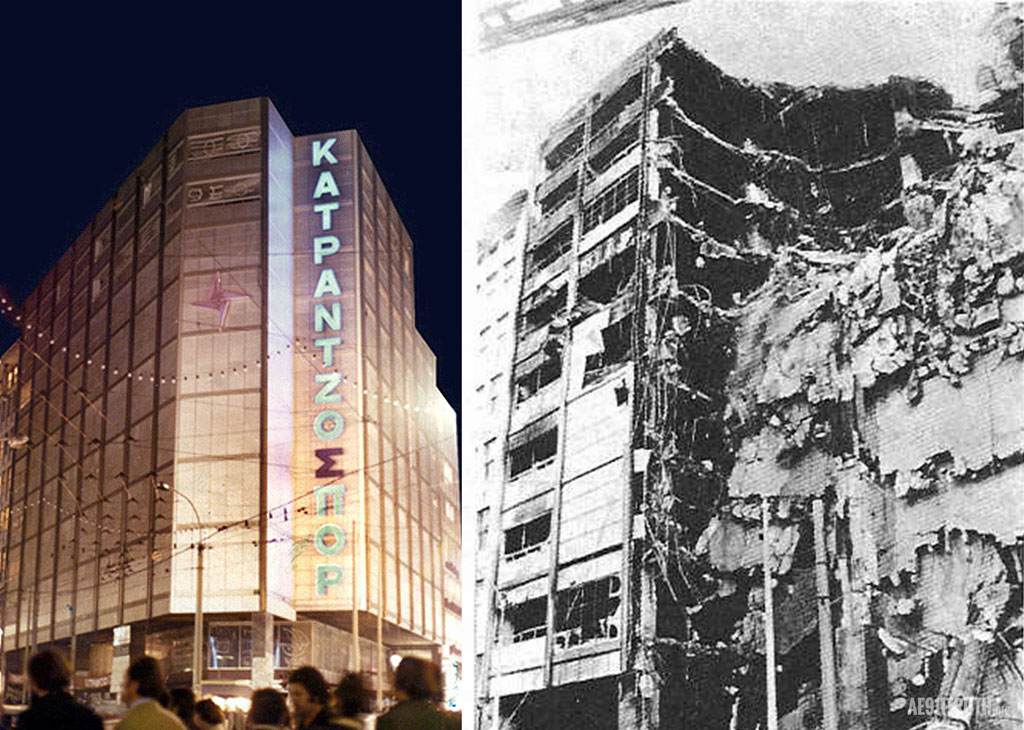
CESP, Sede 2 in Sao Paulo, Brazil (1987)
CESP, Sede 2 was a 21-story reinforced concrete-frame office building with no sprinklers. After a two-hour fire, there was a partial, full-height interior core collapse. Structural damage required that the building be demolished. (Source 1, Source 2)
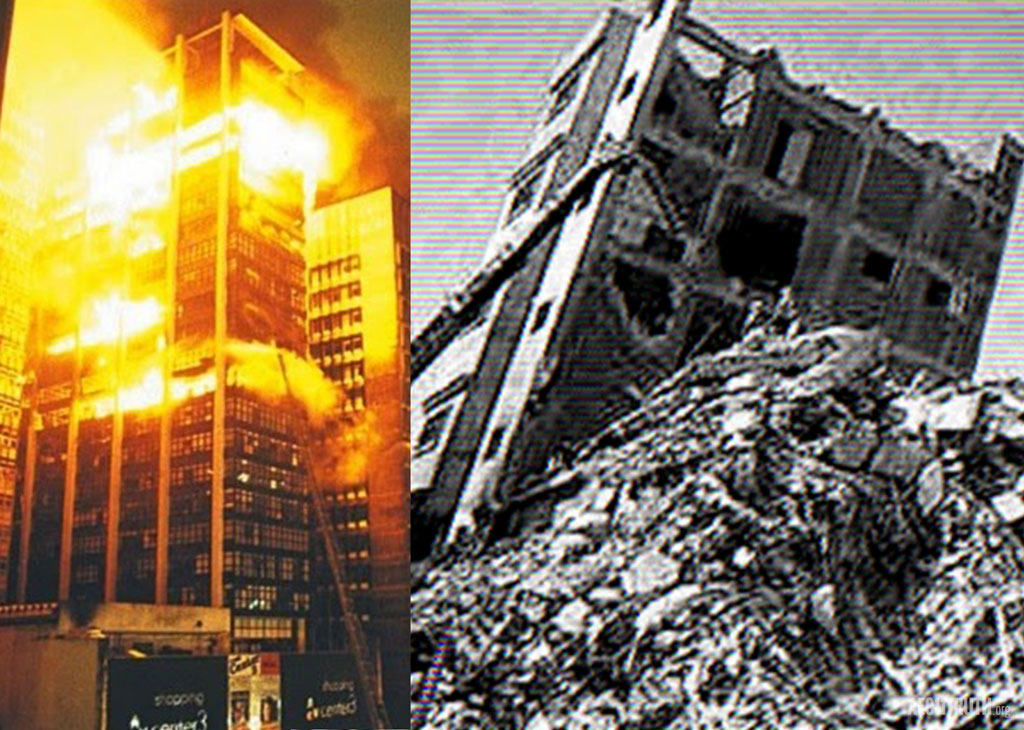
Jackson Street Apartments in Hamilton, Ontario, Canada (2002)
The Jackson Street Apartments is a 21-story reinforced concrete apartment building that experienced a fire on one floor. After the fire was extinguished, all residents of the building except on that floor were eventually allowed to return to their units. Fragments of concrete, as well as lath and plaster, were reported to have injured several firefighters, but no fatalities were reported. A floor/ceiling assembly in the apartment building partially collapsed. (Source 1, Source 2)
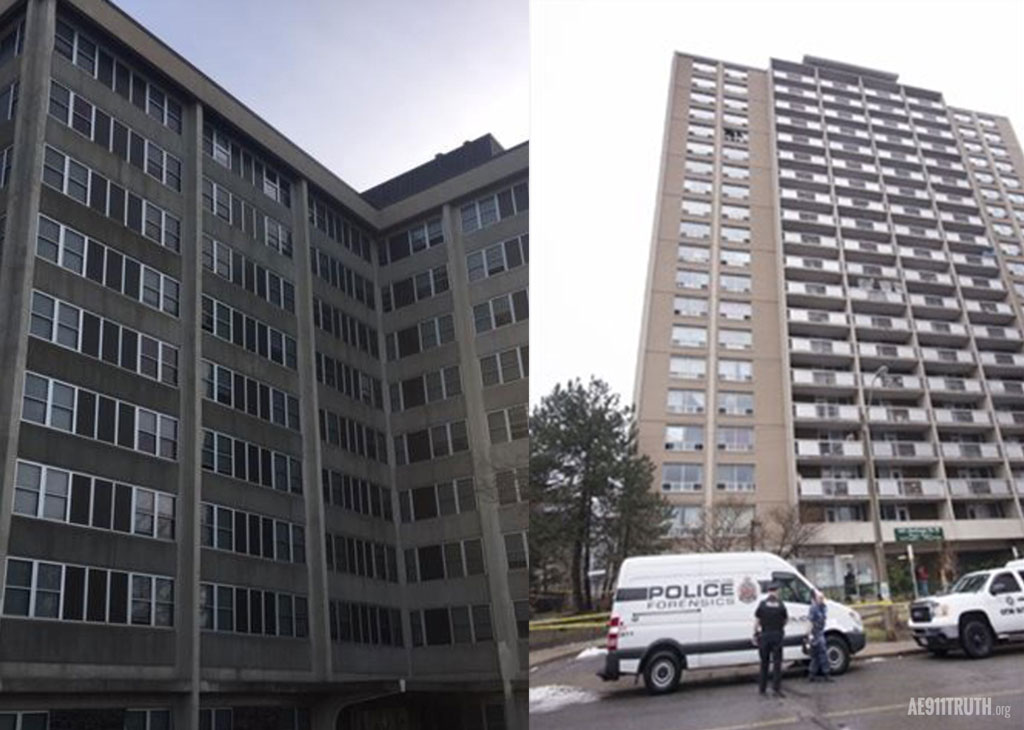
East Parque Central in Caracas, Venezuela (2004)
East Parque Central is a 56-story, 730-foot-high office tower whose 34th floor went up in flames just before midnight on Saturday, October 16, 2004. By Sunday afternoon, the fire had burned for more 17 hours and had spread over 26 floors, reaching the roof. Only two floors and some staircases in the building collapsed. It was feared that the concrete-and-steel structure could be damaged severely enough to collapse. Afterward, engineers who inspected the building found it “very solid,” according to Caracas Fire Chief Rodolfo Briceno. (Source 1, Source 2, Source 3)
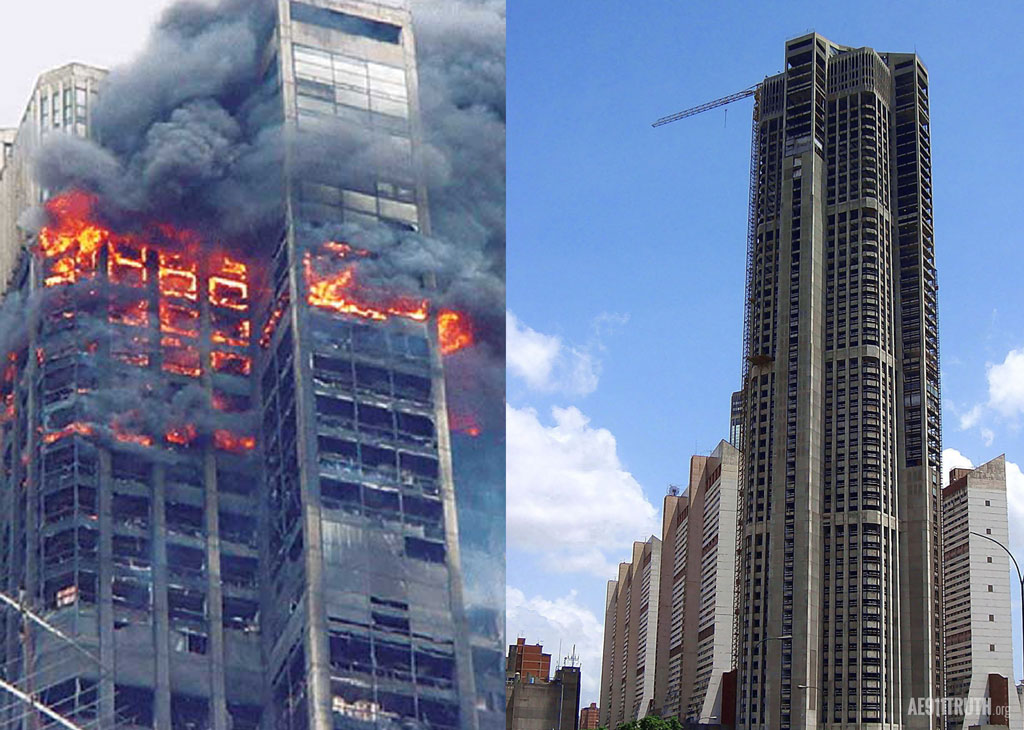
The Windsor Tower in Madrid, Spain (2005)
The Windsor Tower is a 28-story mixture of reinforced concrete and steel framing that was being fireproofed when fire broke out. The not-yet-fireproofed upper 10 floors partially collapsed in stages over a period of more than two hours. Although flames spread down as low as the third floor and lasted up to 20 hours, the already-fireproofed lower 17 floors did not collapse. (Source 1)
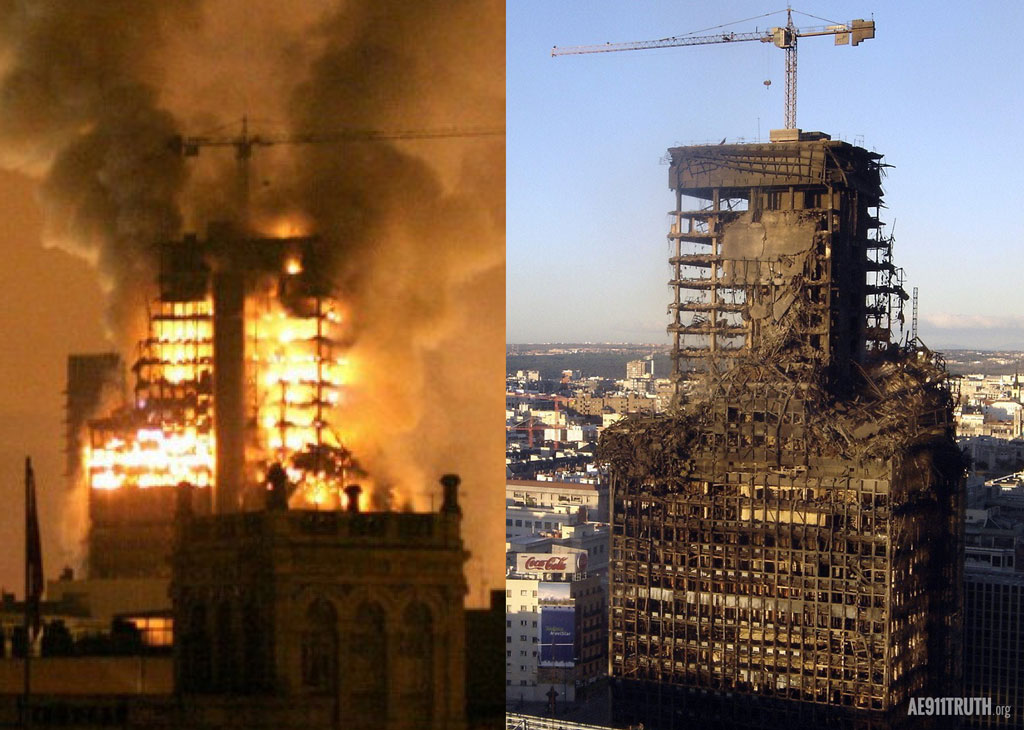
Delft University of Technology’s Faculty of Architecture Building in Delft, Netherlands (2008)
Delft University Faculty of Architecture Building was made of reinforced concrete and steel. The structure consisted of a combination of six three-story structures, which effectively served as a podium, with a 13-story tower on top. The three-story structures included basement, ground floor, and first floor. One morning a fire broke out in a coffee vending machine and spread rapidly and burned for several hours uncontrolled, resulting in the structural collapse of a portion of the building. Though the rest of the building remained standing, despite having been gutted by fire, the damage was so extensive that the decision was made to demolish the entire building. (Source 1)
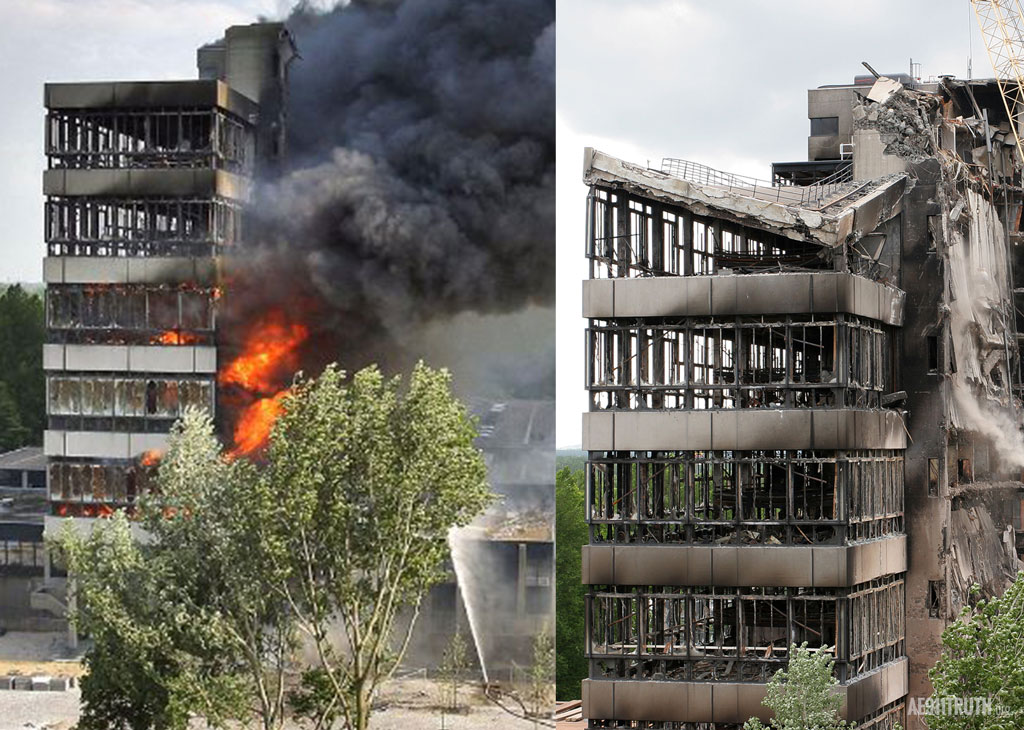
Major High-Rise Fires Followed by Total Collapse
Steel-frame High-rises with Fire Protection
World Trade Center Building 1 in lower Manhattan (2001)
World Trade Center Building 1, also known as the North Tower, was a 110-story, steel-framed, fire-protected structure. When an airplane struck WTC 1 on the morning of September 11, 2001, it damaged floors 93 to 99. The global “collapse” of WTC 1 began on the 98th floor, where the fire insulation on the core columns was not damaged and only seven of the building’s 240 external columns had damaged fire insulation. The National Institute of Standards and Technology said of the Twin Towers’ destruction: “The towers would likely not have collapsed under the combined effects of aircraft impact and the subsequent multi-floor fires if the insulation had not been dislodged or had been only minimally dislodged by aircraft impact” (NIST’s NCSTAR 1-6 p. 284 [PDF p. 366]). The steel columns had a three-hour fire rating and the floor trusses had a two-hour fire rating. Yet only an hour and forty-two minutes after a plane struck the North Tower, it totally “collapsed” to the ground in about 14–16 seconds.[1] (Source 1, Source 2)
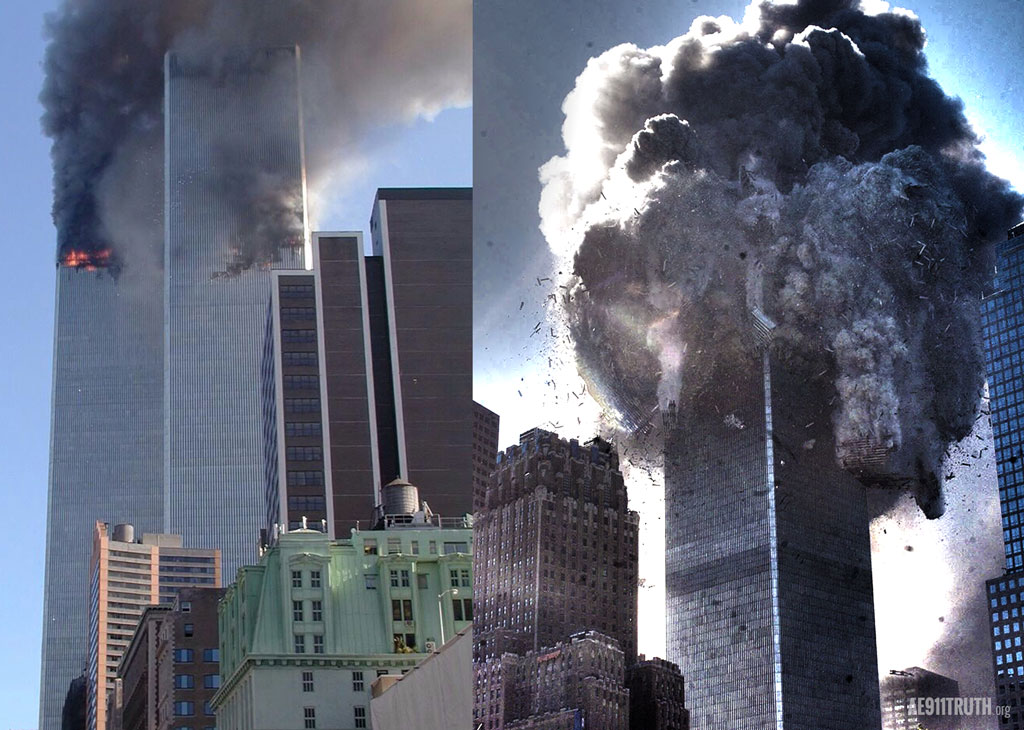
World Trade Center Building 2 in lower Manhattan (2001)
World Trade Center Building 2, also known as the South Tower, was, like its twin, a 110-story, steel-framed, fire-protected structure. It was struck by a second airplane on the morning of September 11, 2001. The hit damaged floors 77 to 85. Although its top 29 floors were falling over to the side, the entire South Tower “collapsed” straight down — in the exact same way as the North Tower had. The building’s righting itself violates Newton’s First Law of Motion: “An object at rest stays at rest and an object in motion stays in motion with the same speed and in the same direction unless acted upon by an unbalanced force.” In other words, the top part should have continued to fall to the side—all the way to the ground. And, there being no weight on the exterior wall opposite to the tilting side, the opposite side of the building could not have been crushed nor could it have collapsed of its own accord. Meaning: Had Newton’s First Law been allowed to operate, the collapse would have been on one side only. Thus, only explosives, aided by incendiaries, could have brought the entire building to the ground. As in the North Tower, the South Tower’s steel columns had a three-hour fire rating and the floor trusses had a two-hour fire rating. Yet a mere 56 minutes after a plane struck the South Tower, it totally “collapsed” to the ground in about 14–16 seconds.[2] (Source 1, Source 2)
[1][2] According to http://911review.com/errors/wtc/times.html: “Each of the Twin Towers totally collapsed in intervals of approximately 14 to 16 seconds. A temporal record of the entire North Tower collapse is provided by the real-time CNN broadcast feed aired during the attack. (This table shows frames from that video at half-second intervals.) It allows reasonably accurate measurement of gross collapse features such as the growth and descent rate of the rubble and dust cloud. However, this and other video evidence does not allow the determination of a precise time of total collapse because each tower’s destruction remains hidden behind an expanding dust cloud which, because of its size, reaches the ground over a span of several seconds.”
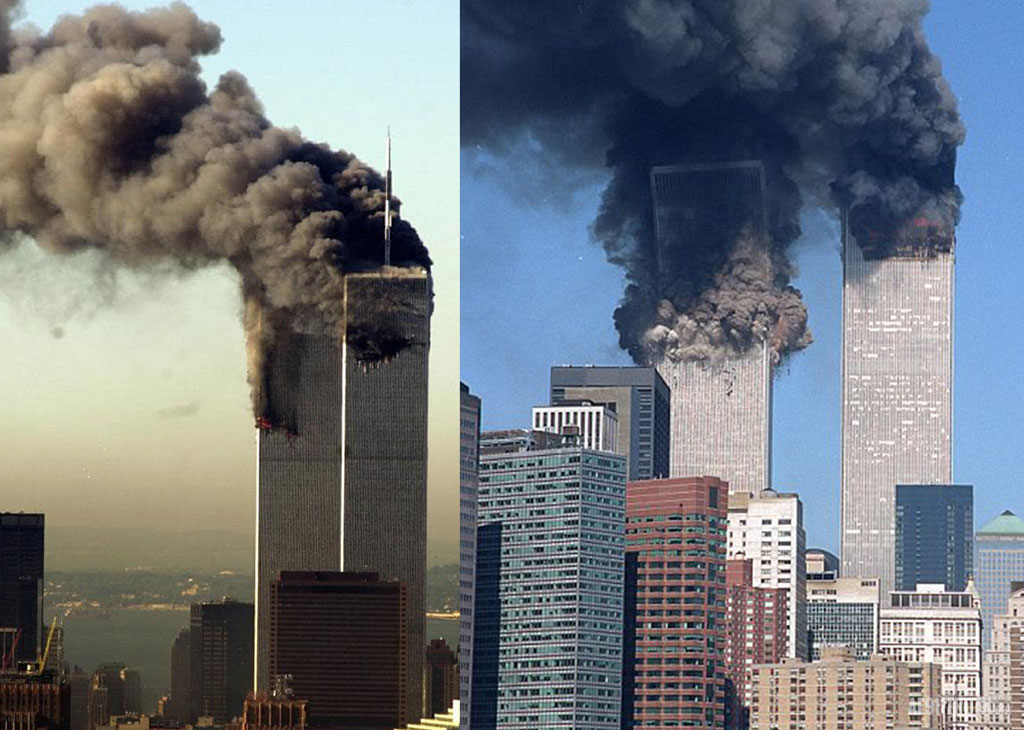
World Trade Center Building 7 in lower Manhattan (2001)
World Trade Center Building 7 was a 47-story, steel-framed, fire-protected building. Like the Twin Towers, WTC 7’s steel columns had three-hour fire protection and its steel floor beams two-hour fire protection. Yet it “collapsed” completely, symmetrically, into its own footprint on the afternoon of September 11, 2001. The “collapse” supposedly began in an area where the fire protection was not damaged. The entire structure, which was not hit by a plane and experienced normal office fires, came straight down at 5:20 PM in less than seven seconds. Some 100 feet of its plummet was clocked at free-fall acceleration. (Source 1, Source 2, Source 3)
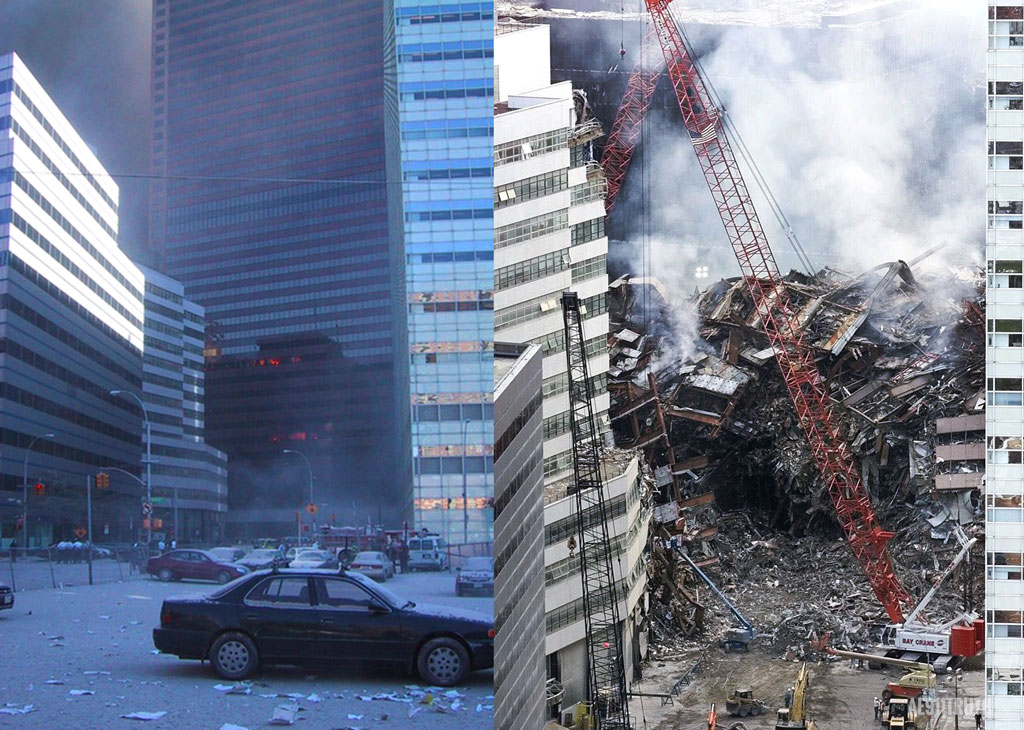
Other Types of Construction and Fireproofing
An apartment block in St. Petersburg, Russia (2002)
An apartment block in St. Petersburg was a nine-story concrete structure that totally collapsed after a fire lasting approximately one hour. The news services reported only one related casualty. About 400 other residents were safely evacuated from the burning building prior to collapse. (Source 1)
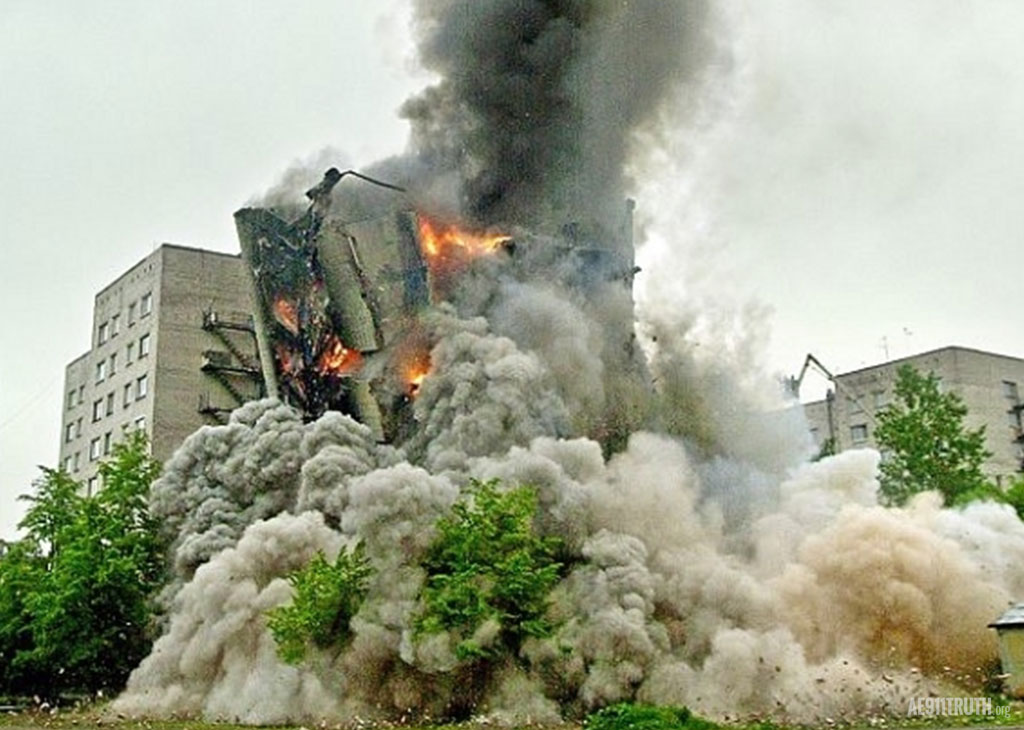
A fifteen-story building in Cairo, Egypt (2004)
A fifteen-story building in Cairo was a reinforced-concrete structure, collapsed after a fire broke out in Souq al-Wahda, a small appliance store on the ground floor. When the building was constructed in 1981, it was eleven floors, but, according to police, the owner had illegally added four more floors. An order from the city to tear down the extra floors was never executed. Six days before the blaze, tenants complained to police that renovation in the appliance store could damage the building’s foundations. Building collapses, common in Egypt, are often caused by shoddy construction or the unauthorized building of extra stories. As a result of the fire, the building completely collapsed. (Source 1)
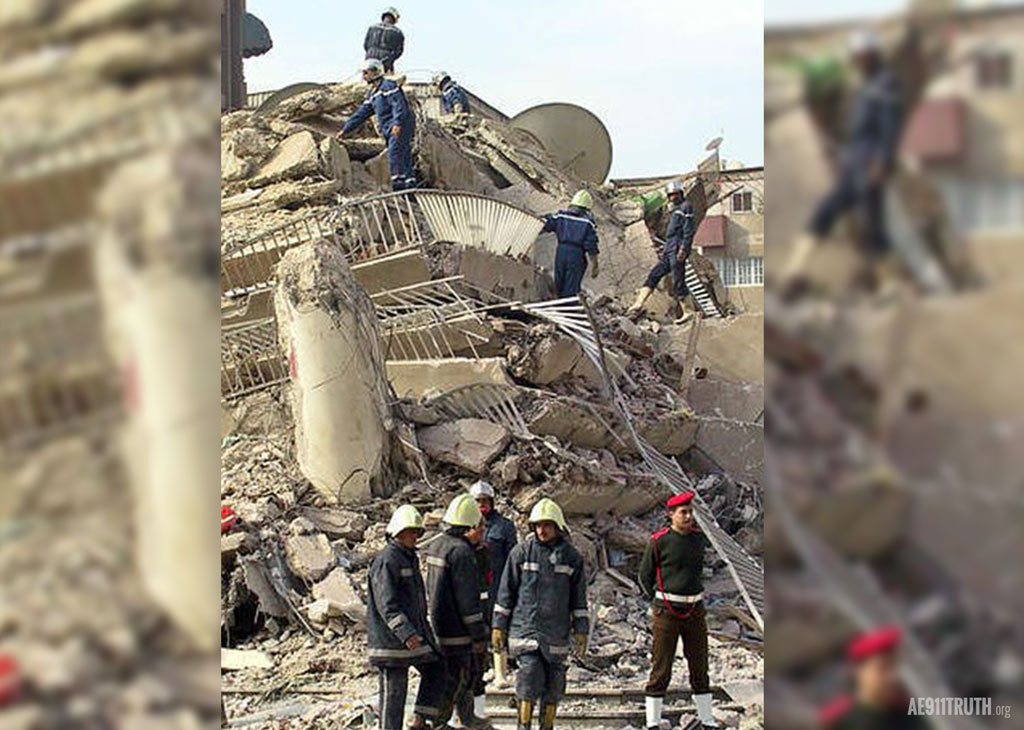
Plasco Building in Tehran, Iran (2017)
The Plasco Building was a 15-story steel-frame high-rise constructed in 1962. At the time, it was the tallest building ever built in Iran. Neither passive nor active fire safety measures were implemented in the building (i.e., it contained no fireproofing). On the morning of January 19, 2017, it caught fire at around 8:00 local time (4:30 AM GMT). After battling the blaze for a little over three hours, Tehran firefighters believed the fires were under control. Then, at around 11:20 AM, a series of powerful explosions occurred inside the building and were visible from the outside. Within a few minutes of the first reported explosion, the building suffered a total collapse that lasted approximately 15 seconds, killing 16 firefighters and six civilians. Molten metal was documented in photos and videos of the debris pile.
AE911Truth published a preliminary report one month after the incident recommending that controlled demolition involving a combination of explosives and incendiaries be considered as the most likely hypothesis. Given the overwhelming evidence for controlled demolition, including the well-documented series of explosions that occurred just prior to collapse, it is both astonishing and troubling that engineers outside of Iran — with no apparent bias other than their adherence to the official explanation of the WTC destruction — have attributed this collapse to fires that had been almost completely extinguished. (Source 1, Source 2)
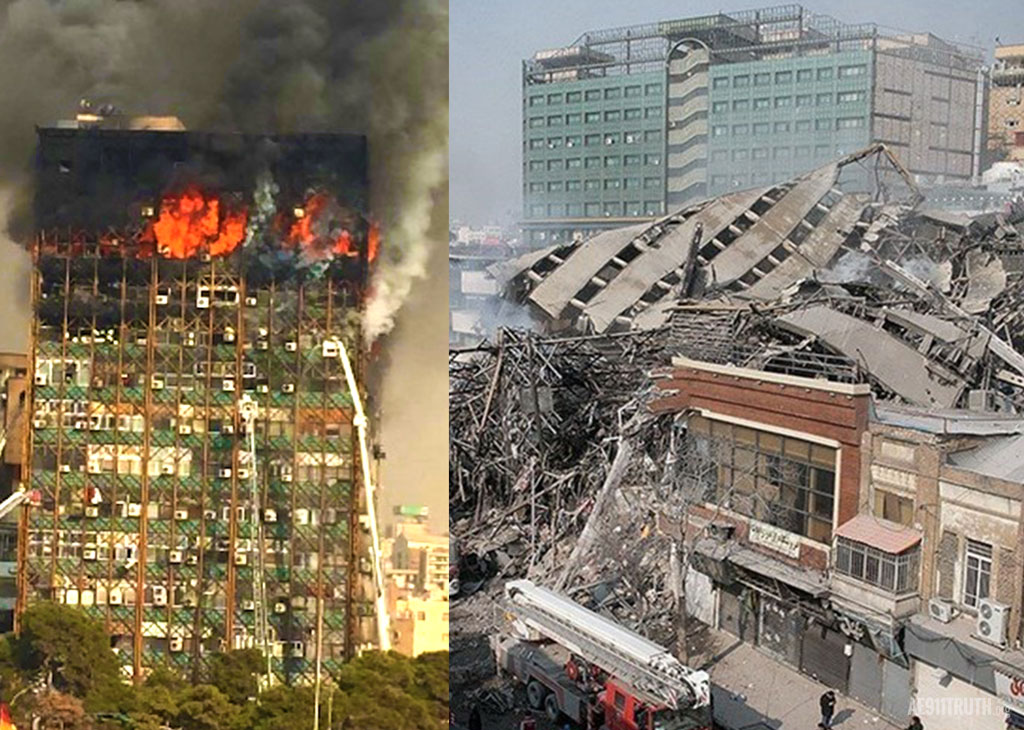
Wilton Paes Almeida Building in São Paulo, Brazil (2018)
The Wilton Paes Almeida Building was one of two side-by-side high-rise structures that were built in the 1960s. Made with a mixture of concrete and steel, its central core of concrete elevators and stairs and its four massive steel columns were not fire-protected. At the time of its construction, the kind of thermal protection prevalent in more modern structures was non-existent. The building had been left abandoned in 2002, but by 2018, hundreds of squatter tenants filled each floor. They used fuel oil for cooking and heating, practices that made the building’s wood-framed walls extremely susceptible to dangerous fires. When a fire broke out in the Wilton Paes, it became massive in no time, quickly and completely engulfing the entire building. The unprotected empty elevator shafts acted as giant chimneys. The building collapsed completely in just seconds.
AE911Truth has not studied the Wilton Paes Almeida Building incident in great detail and thus favors no hypothesis for the cause of its collapse. However, the combination of sounds recorded immediately prior to the collapse with the suddenness, symmetry, and completeness of the destruction suggests that controlled demolition should not be ruled out without careful investigation. (Source 1, Source 2, Source 3)
